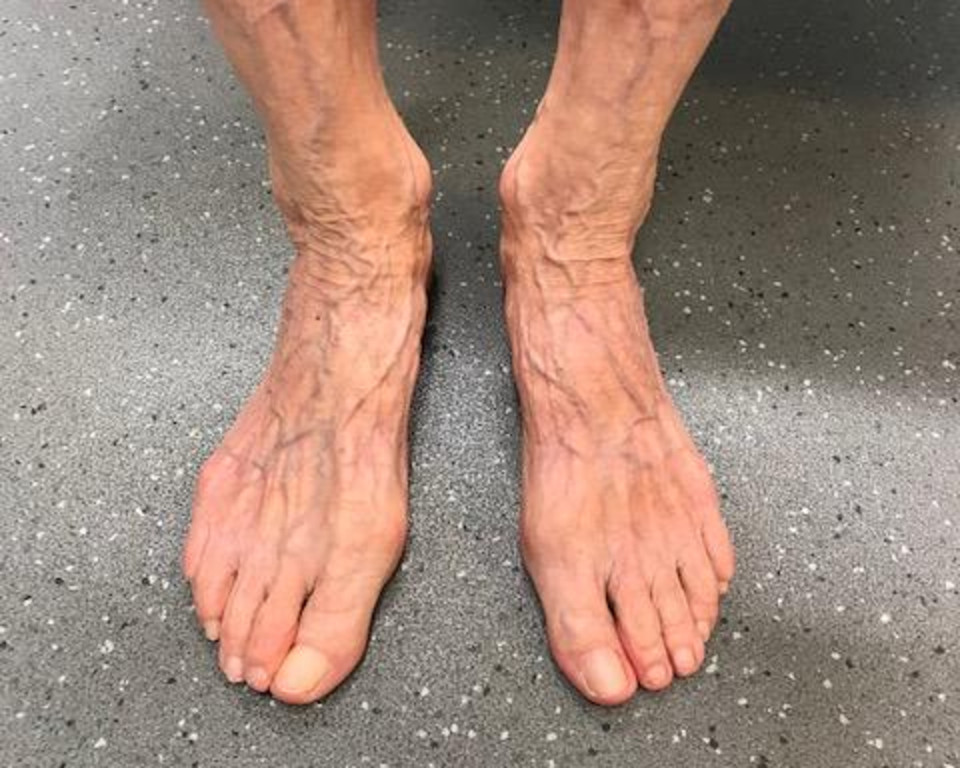What problems are associated with ageing feet?
As we age, we naturally develop more problems with our feet due to normal daily wear and tear of joints, but also because the skin starts to become thin and loses its elasticity, as well as being dry and much more fragile. Foot pain can be debilitating. As we only have one pair of feet, it’s important to take good care of them. Foot pain can also lead to issues with walking and exercising, which are an important part of health and wellbeing as we age.
Additionally, if we have trouble with mobility, this can impact on getting out and about and involvement in social activities, which become ever more important as we get older. As long as we take routine care of our feet, serious problems can usually be avoided. However, ageing can also mean that we develop other conditions, such as diabetes and arthritis, which in some cases can affect the foot and lead to requiring treatment. Healing may also take longer.
What are the signs of ageing feet?
Feet can start to show signs of ageing at any age if good routine foot care is not practised, but generally it is most common from your fifties onwards. General signs of ageing feet include more regular aches and pains; developing bunions; signs of clawing of the toes; and general circulatory problems.
What are the treatments?
Treatments depend on which particular condition you are suffering from, e.g. bunions, and therefore the best advice is to visit your local Podiatrist if your foot care routine is not alleviating the symptoms.
When should I see a podiatrist?
As we get older, an Annual Foot Health check is as important as a sight or hearing test. Conditions like Diabetes or circulatory problems can all be picked up by looking at the feet, and common problems like corns, cracked skin and ingrown toenails can be successfully treated.
If you experience any foot care issues that do not resolve themselves naturally or through routine foot care within three weeks, you should seek the help of a healthcare professional.

What can I do to reduce the effects of ageing?
Painful and uncomfortable feet aren’t a natural part of growing old or something to put up with. A lot can be done to improve comfort, relieve pain and maintain mobility.
Exercise
Keeping active and on the move helps to keep feet healthy. It tones up muscles, helps to strengthen arches and stimulates blood circulation.
General foot care and protection
Keeping toenails cut and under control is key as nails that become too long can press against the end of the shoe and the constant pressure can cause soreness, infection and ulceration. Toenails that have been poorly cut can also become ingrown.
Additionally, checking your feet regularly, daily if necessary, and moisturising them (but not between the toes) will help them keep supple as feet start to dry out and lose their natural oils as they age.
We also start to lose the fatty pads that cushion the bottom of the feet, and soles and heels become dry and nails brittle and more difficult to manage.
Keeping your feet warm is also important, but do not warm them too close to the fire! Warm stockings or socks can help, but avoid anything too tight which can restrict your circulation or cramp your toes.
Wearing fleece-lined boots or shoes or even an extra pair of socks will also keep you warm but do make sure your shoes aren’t tight as a result. Bed socks are also a good idea.
Footwear
The older you get, the more important it is to wear a shoe that is comfortable, well-fitting and holds your foot firmly in place to give adequate support.
Many people wear slippers if their feet are hurting but this can make things worse as slippers encourage you to shuffle rather than letting the joints work as they should.
A pair of running shoes is the best option as these provide a good amount of shock absorption; stability; and arch support.
Avoid plastic easy clean uppers, which don’t allow the foot to breathe and won’t stretch to accommodate your own foot shape.
Many shoes have cushioning or shock-absorbing soles to give you extra comfort while walking.
When buying shoes, ensure that you can put them on and take them off easily. Check that the heel is held firmly in place: you’ll find that a lace, strap, buckle or velcro-fastening shoe will give more support and comfort than a slip-on.
Your shoes should be roomy enough, particularly if you intend to wear them every day.
If you suffer with swollen feet, it’s a good idea to put your shoes on as soon as you wake up, before your feet have had a chance to swell.
© Walkwel Ltd 2025.
Registered in England #08928649
Registered VAT Number: GB121089836
An indicoll website
Privacy PolicyCookie PolicyDisclaimerAccessibility
